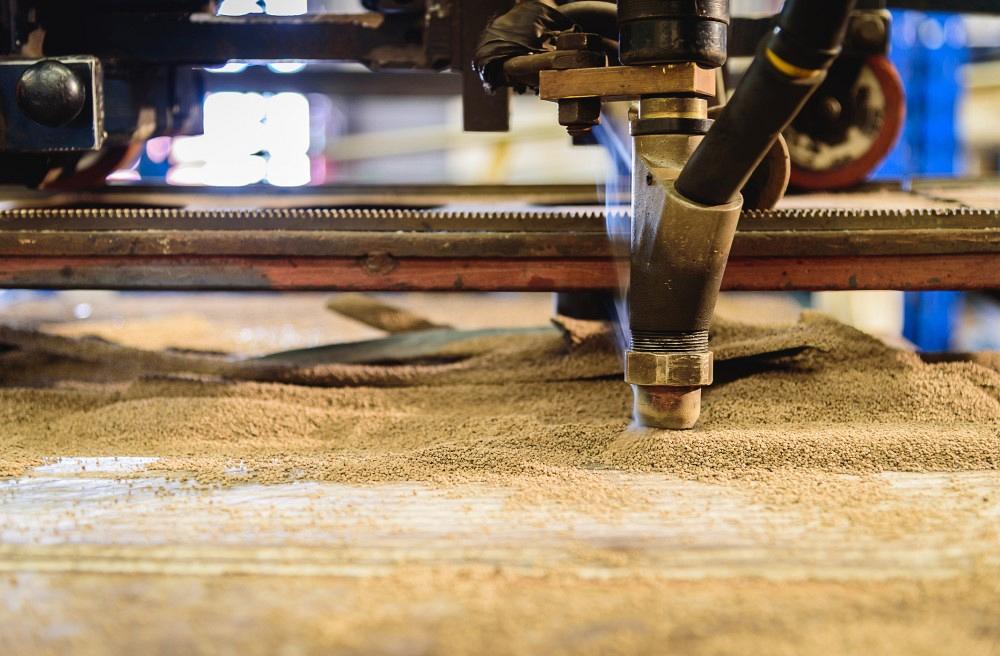Technical Liaison Manager
- FMA
- The Fabricator
- FABTECH
- Canadian Metalworking
Categories
- Additive Manufacturing
- Aluminum Welding
- Arc Welding
- Assembly and Joining
- Automation and Robotics
- Bending and Forming
- Consumables
- Cutting and Weld Prep
- Electric Vehicles
- En Español
- Finishing
- Hydroforming
- Laser Cutting
- Laser Welding
- Machining
- Manufacturing Software
- Materials Handling
- Metals/Materials
- Oxyfuel Cutting
- Plasma Cutting
- Power Tools
- Punching and Other Holemaking
- Roll Forming
- Safety
- Sawing
- Shearing
- Shop Management
- Testing and Measuring
- Tube and Pipe Fabrication
- Tube and Pipe Production
- Waterjet Cutting
Industry Directory
Webcasts
Podcasts
FAB 40
Advertise
Subscribe
Account Login
Search
Improving results in flat-position submerged arc welding
Look to flux and electrodes to boost quality on the weld
- By David Meyer and Rob Koltz
- January 23, 2024

The Consumables Corner team helps a shop that’s struggling with submerged arc welding quality when welding in the flat position. Kapook2981 / iStock / Getty Images Plus
Q: We're a bridge and structural steel shop and we do a lot of submerged arc welding (SAW). Most of the welding is done in the flat position and some in the horizontal. We struggle with weld bead quality when running large single-pass welds in the flat position per our welding procedure specifications. There are inconsistencies in the toe wetting, the weld ripples are very rough, and the slag often sticks to the weld. Any suggestions?
A: Yes, SAW fundamentals tend to get overlooked in these applications and similarly in deep groove welds. Several things, individually or combined, can result in the issues you’ve mentioned.
One cause is excessive flux burden (the amount of flux deposited). Excessive flux burden can cause weld bead distortion, as well as pockmarking and porosity. Inconsistent weld toes and rough weld ripples, known as chevrons, stem from the weight of the excessive flux.
Flux burden should be deep enough to prevent welding arc flash-through but still allow the operator to see the bottom of the contact tip. If you are using the shroud-type flux nozzle (which surrounds the contact tip), then measure the distance from the bottom of the contact tip to the bottom of the flux shroud and subtract that value from the predetermined contact-tip-to-work distance (CTTWD). This value will be the bottom of the shroud to the bottom of the weld joint or surface.
If the flux burden is adjusted and controlled appropriately, then the weld bead size may be an issue. Welding in the flat position allows for larger weld beads, which correlates to higher heat input and a more fluid weld puddle that can be more easily affected by the weight of the flux burden. Ensure the welding torch is in a slight drag angle of 3 to 5 degrees to the travel direction and that travel speed is high enough to prevent the weld puddle from advancing in front of the welding arc. Elevating one end of the workpiece a small amount and welding uphill can also prevent the puddle from advancing in front of the arc.
The type of flux and its features also can affect the welding outcome. High basicity fluxes, designed to provide better impact toughness, have smaller operating ranges and are less forgiving than fluxes designed for welding performance.
The condition of the flux also can be a factor. Flux that has been through many weld and recovery cycles will have many more fine particles than new flux. Add new flux frequently to maintain a proper particle size distribution. Unprotected flux will absorb water from the atmosphere over time and cause surface indications. After opening the flux bag, keep the flux in ovens or heated hoppers, and discard wet flux.
Welding parameters such as amps, volts, travel speed, electrode extension, and welding polarity also contribute to the outcome. Oftentimes, a small adjustment to one of these will greatly improve the bead appearance.
Using direct current electrode negative (straight polarity) at higher amperages can lead to arc instability and defects. Direct current electrode positive (reverse polarity) or alternating current are preferred polarities for these applications.
The CTTWD, also called electrode extension, should be approximately eight times the diameter of the welding electrode. The predetermined CTTWD is set and controlled during welding by automated devices. This maintains deposition rates for constant-amperage welding or weld penetration for constant-voltage (wire) welding modes. Since the flux delivery nozzle is attached to the welding head, flux burden depth remains consistent.
subscribe now

The Welder, formerly known as Practical Welding Today, is a showcase of the real people who make the products we use and work with every day. This magazine has served the welding community in North America well for more than 20 years.
start your free subscriptionAbout the Authors


Rob Koltz
Application Engineer
411 S. Ebenezer Rd.
Florence, 29501
636-485-2253
About the Publication
Related Companies
- Stay connected from anywhere

Easily access valuable industry resources now with full access to the digital edition of The Fabricator.

Easily access valuable industry resources now with full access to the digital edition of The Welder.

Easily access valuable industry resources now with full access to the digital edition of The Tube and Pipe Journal.
- Podcasting
- Podcast:
- The Fabricator Podcast
- Published:
- 04/16/2024
- Running Time:
- 63:29
In this episode of The Fabricator Podcast, Caleb Chamberlain, co-founder and CEO of OSH Cut, discusses his company’s...
- Trending Articles
Sheffield Forgemasters makes global leap in welding technology

ESAB unveils Texas facility renovation

Engine-driven welding machines include integrated air compressors

How welders can stay safe during grinding

The impact of sine and square waves in aluminum AC welding, Part I

- Industry Events
16th Annual Safety Conference
- April 30 - May 1, 2024
- Elgin,
Pipe and Tube Conference
- May 21 - 22, 2024
- Omaha, NE
World-Class Roll Forming Workshop
- June 5 - 6, 2024
- Louisville, KY
Advanced Laser Application Workshop
- June 25 - 27, 2024
- Novi, MI


























